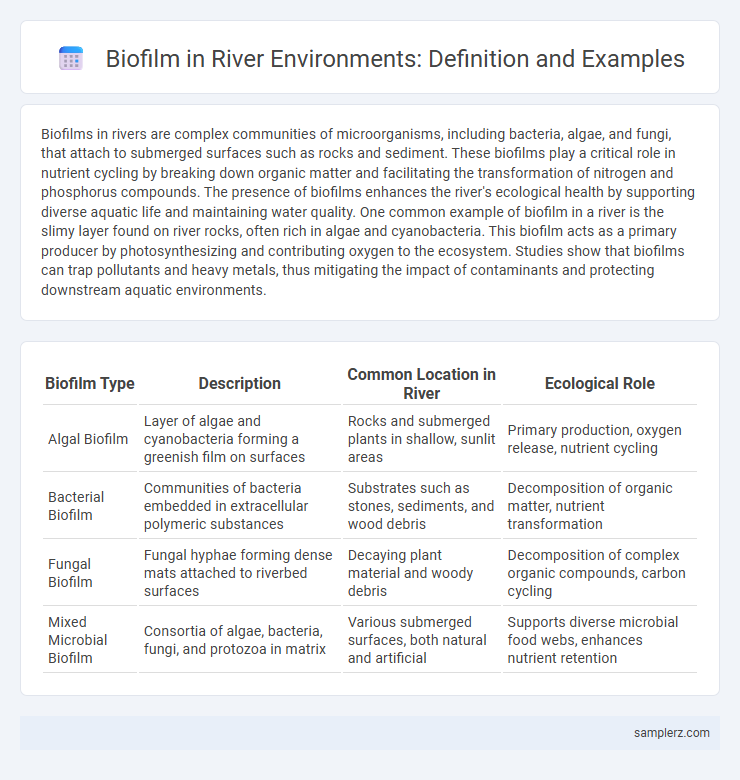Biofilms in rivers are complex communities of microorganisms, including bacteria, algae, and fungi, that attach to submerged surfaces such as rocks and sediment. These biofilms play a critical role in nutrient cycling by breaking down organic matter and facilitating the transformation of nitrogen and phosphorus compounds. The presence of biofilms enhances the river's ecological health by supporting diverse aquatic life and maintaining water quality. One common example of biofilm in a river is the slimy layer found on river rocks, often rich in algae and cyanobacteria. This biofilm acts as a primary producer by photosynthesizing and contributing oxygen to the ecosystem. Studies show that biofilms can trap pollutants and heavy metals, thus mitigating the impact of contaminants and protecting downstream aquatic environments.
Table of Comparison
| Biofilm Type | Description | Common Location in River | Ecological Role |
|---|---|---|---|
| Algal Biofilm | Layer of algae and cyanobacteria forming a greenish film on surfaces | Rocks and submerged plants in shallow, sunlit areas | Primary production, oxygen release, nutrient cycling |
| Bacterial Biofilm | Communities of bacteria embedded in extracellular polymeric substances | Substrates such as stones, sediments, and wood debris | Decomposition of organic matter, nutrient transformation |
| Fungal Biofilm | Fungal hyphae forming dense mats attached to riverbed surfaces | Decaying plant material and woody debris | Decomposition of complex organic compounds, carbon cycling |
| Mixed Microbial Biofilm | Consortia of algae, bacteria, fungi, and protozoa in matrix | Various submerged surfaces, both natural and artificial | Supports diverse microbial food webs, enhances nutrient retention |
Introduction to Biofilms in River Ecosystems
Biofilms in river ecosystems consist of complex communities of microorganisms, including bacteria, algae, and fungi, embedded in a self-produced extracellular matrix adhering to submerged surfaces. These biofilms play a crucial role in nutrient cycling, organic matter decomposition, and providing habitat for aquatic organisms. Their formation influences water quality, sediment stability, and overall ecosystem health.
Common Bacterial Species in River Biofilms
Common bacterial species in river biofilms include Proteobacteria, Bacteroidetes, and Cyanobacteria, which dominate microbial communities due to their ability to adhere to submerged surfaces. Species such as Pseudomonas aeruginosa and Bacillus subtilis contribute to nutrient cycling and organic matter degradation within these biofilms. These bacteria form complex extracellular polymeric substances that protect the biofilm and enhance its resilience in fluctuating river environments.
Biofilm Formation on River Rocks and Substrates
Biofilm formation on river rocks and substrates plays a crucial role in aquatic ecosystems by providing habitat and food for various microorganisms and invertebrates. These biofilms consist of diverse communities of bacteria, algae, fungi, and extracellular polymeric substances that adhere to submerged surfaces, enhancing nutrient cycling and organic matter decomposition. The structural stability of biofilms on riverbeds helps reduce erosion and improves water quality by filtering pollutants and capturing sediments.
Role of Biofilms in River Nutrient Cycling
Biofilms in rivers consist of microbial communities attached to submerged surfaces, playing a crucial role in nutrient cycling by trapping and transforming organic and inorganic materials. These biofilms facilitate the breakdown of pollutants, enhance nitrogen fixation, and mediate phosphorus retention, thereby regulating nutrient availability in aquatic ecosystems. Their metabolic activities support biodiversity and contribute to the overall health and stability of riverine environments.
Impact of Biofilms on River Water Quality
Biofilms in rivers consist of microbial communities attached to submerged surfaces, significantly influencing water quality by trapping pollutants and organic matter. These biofilms enhance nutrient cycling but can also contribute to oxygen depletion and the accumulation of harmful contaminants. Their presence alters the river's biochemical processes, impacting aquatic ecosystems and overall water health.
Biofilms and Microplastic Accumulation in Rivers
Biofilms in rivers serve as hotspots for microplastic accumulation, where microbial communities adhere to plastic particles, enhancing their persistence in aquatic ecosystems. These biofilm-coated microplastics can alter nutrient cycling and provide surfaces for pollutant adsorption, impacting water quality and riverine biodiversity. Understanding biofilm-microplastic interactions is crucial for assessing pollutant dynamics and developing effective river management strategies.
Case Studies of Biofilm Communities in Major Rivers
Biofilm communities in major rivers such as the Mississippi, Amazon, and Yangtze demonstrate diverse microbial structures that play critical roles in nutrient cycling and contaminant degradation. Studies in the Rhine River revealed biofilms dominated by bacteria like Pseudomonas and Bacillus, which enhance organic matter decomposition and heavy metal sequestration. These biofilms act as bioindicators of water quality, reflecting seasonal and pollution-driven changes in riverine ecosystems.
Biofilm Interaction with Aquatic Plants and Animals
Biofilms in rivers form complex microbial communities that adhere to surfaces of aquatic plants and animals, facilitating nutrient cycling and providing habitat for microorganisms. These biofilms enhance water quality by breaking down pollutants and serve as a crucial food source for invertebrates and fish. Their interactions influence the health and growth of aquatic plants, affecting overall riverine ecosystem dynamics.
Environmental Factors Influencing River Biofilm Growth
River biofilm growth is strongly influenced by environmental factors such as nutrient availability, light intensity, and water flow rate. Elevated nutrient levels, particularly nitrogen and phosphorus, enhance microbial proliferation, while optimal light exposure supports photosynthetic algae within the biofilm. Conversely, high flow rates can disrupt biofilm structure by increasing shear stress, limiting colonization and development.
Monitoring and Management of River Biofilms
River biofilms, composed of microbial communities such as algae, bacteria, and fungi, serve as key indicators of water quality and ecosystem health. Advanced monitoring techniques like molecular analysis and remote sensing facilitate early detection of biofilm changes caused by pollutants or nutrient fluctuations. Effective management strategies, including controlled flow regimes and pollutant reduction, help maintain balanced biofilm development and preserve riverine biodiversity.

example of biofilm in river Infographic
 samplerz.com
samplerz.com